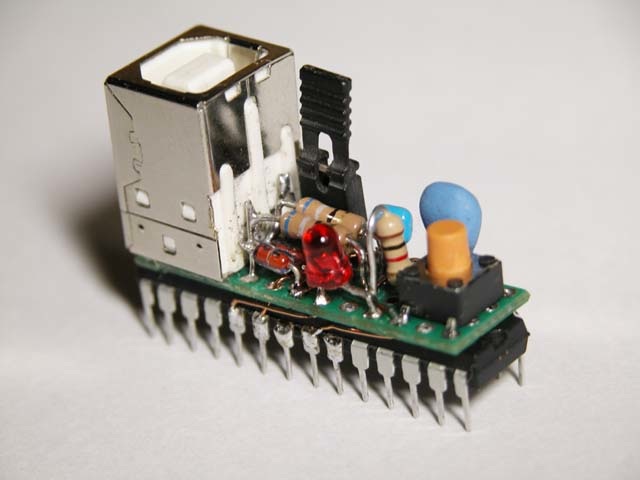Minimalist Arduino
Jump to navigation
Jump to search
- Variation on dead-bug soldering from [1] fo make a functional arduino:
Assessment
For this to be functional:
 We need a source of clean 5V power such as a computer or USB power supply (USB B). This is easy.
We need a source of clean 5V power such as a computer or USB power supply (USB B). This is easy. We need to connect to specific pins. Yes, this is doable simply by using female Dupont wire directly connected to the pins of the chip.
We need to connect to specific pins. Yes, this is doable simply by using female Dupont wire directly connected to the pins of the chip. For this to be programmed, we need a USB to serial interface, which this doesn't appear to include. However, we can program this chip by inserting into another Arduino Uno.
For this to be programmed, we need a USB to serial interface, which this doesn't appear to include. However, we can program this chip by inserting into another Arduino Uno.
Thus, this would completely work to control things when powered up, such as a minimalist CEB Press. This could be a great apocalyptic option if one had components but no circuit boards/proto boards of any type to solder/plug onto.
Further Simplification
More simple option for a functional Arduino appears to be:
- USB B port - to plug into ubiquitous USB ports using a USB A to USB B male-male cable
- Atmega 328P chip
- 2 wires from USB port to power up the chip.
- Crystal oscillator on pins 9 and 10, with 22 pf capacitors to pins 9 and 10
That's it! To connect to outputs or inputs - use Dupont wire.
Furthest Simplification
For the radicals in the house, here is the absolute absolute minimum
- Atmega 328P chip
- Oscillator mechanism - crystal oscillator on pins 9 and 10, with 22 pf capacitors to pins 9 and 10
That's it! Power is supplied via a reliable power source to the +5 and ground via Dupont wires, and crystal is soldered directly to pins 9 and 10. Capacitors are soldered between 9 and 10 and ground.
